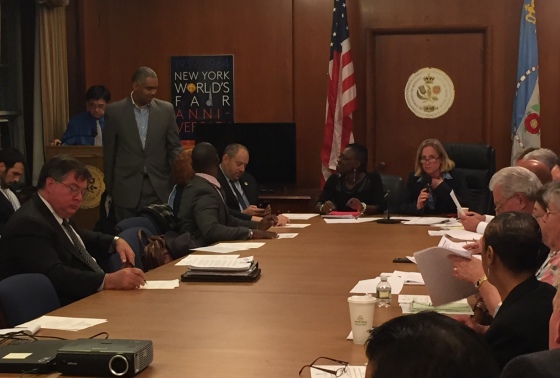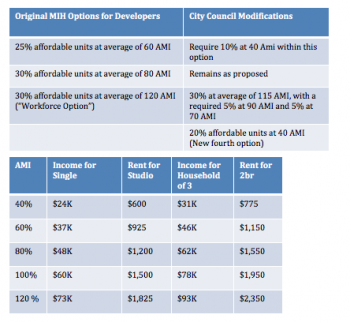
The Queens Borough Board rejected the zoning amendments
March 15, 2016 By Jackie Strawbridge
The City Council has reached a compromise with Mayor Bill de Blasio on two zoning amendments that are crucial to his affordable housing plan for the City.
The zoning amendments, called Mandatory Inclusionary Housing (MIH) and Zoning for Quality and Affordability (ZQA), were designed to promote the construction of affordable housing and high quality developments.
However, local communities including in western Queens found several problems within the zoning amendments, on top of a fundamental concern with the City’s push to create more housing in already crowded neighborhoods.
The Council has “heard New Yorkers loud and clear,” in the words of Speaker Melissa Mark-Viverito, and offered numerous modifications to the original MIH and ZQA proposals.
MIH requires developers to include affordable housing units in their projects, if building on land that has been rezoned to increase housing capacity. As a part of their compromise with the Mayor, the Council added requirements to MIH that lowers the income levels that would be incorporated into these developments.
 The Council also created a new way for developers to build affordable housing that accommodates families making around $31,000 per year – lower than the income brackets included in the original MIH proposal.
The Council also created a new way for developers to build affordable housing that accommodates families making around $31,000 per year – lower than the income brackets included in the original MIH proposal.
The compromise also aims to get rid of escape hatches that would enable developers to skirt affordable housing requirements.
This issue was brought up by Community Board 2 during the discussion of the text amendments.
Under de Blasio’s MIH, developers can waive affordability requirements by claiming financial hardship through the Board of Standards and Appeals. Long Island City residents, who have long seen developers bypass zoning requirements through the BSA, took issue with this possibility.
The Council has added steps to this process, including notification of any BSA application to the affected community board and council member. Permits will also expire in four years unless significant construction has begun.
The Council deal also attempts to de-incentivize the construction of off-site affordable housing, which is permitted through MIH, and which raised red flags at a CB 2 discussion last October.
New rules state that offsite housing must produce five percent more affordable units, and developers will not be granted additional height for their market-rate projects if they put affordable housing offsite.
Within ZQA, the elimination of certain parking requirements at affordable housing in districts that are served by public transportation was a major source of contentioun in western Queens.
The Council is working to carve out modifications to the “transit zone” defined by ZQA where these parking reductions applied. A spokesperson said that the modified transit area is still being drawn up.
While these modifications tailor MIH and ZQA to local concerns, the endgame remains the creation of new housing stock in New York, which has put western Queens residents on edge for months.
Pat O’Brien, chairman of Community Board 2, told Borough President Melinda Katz when the amendments were being discussed, “we don’t have an infrastructure that can bear what the result of this could be.”
He has repeatedly characterized the zoning proposal as “trying to fit 10 pounds into a five-pound bag.”
Astoria’s community board approved the zoning amendments last fall, but on several conditions, including that any rezoning be accompanied by an upgrade in infrastructure, such as schools, utilities or mass transit.
Councilman Jimmy Van Bramer represents Community Board 2 and the Dutch Kills section of Community Board 1.
A spokesperson said Van Bramer is still determining his position on the new versions of MIH and ZQA and how he intends to vote is “not yet public.”
5 Comments

They will be built anyway. So postpone it until space is very limited.
“A spokesperson said Van Bramer is still determining his position on the new versions of MIH and ZQA and how he intends to vote is “not yet public.”
Oh boy, you know what this means. He is going to sell us out.
Just build affordable housing please. Enough snobby yuppies and hipsters here already. Better yet LIC is overcrowded. just STOP BUILDING PERIOD….
Yes! There is no more room! Just one example: when a person can’t get on the overcrowded E train at 7:30am, which is right before the massive rush hour, it’s a problem! It will only get worse much like the 7 already has!
Now you’re just being dickish.